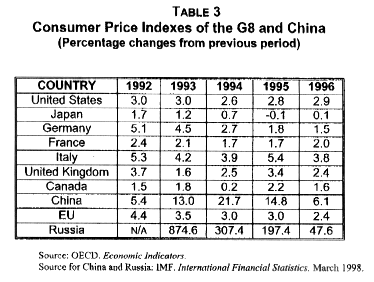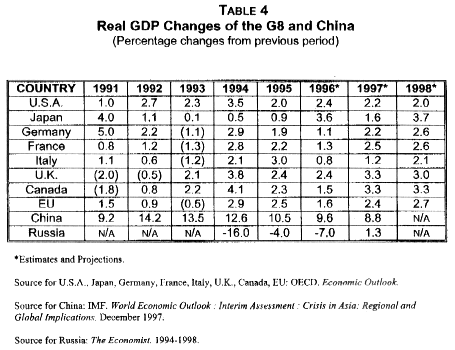|
|
|
|
From G7 To G8:
Evolution, Role and Documentation of a Unique Institution
Peter I. Hajnal
Columbia International Affairs Online
April 1998
The Players
Summit delegations of each G7/G8 country include the head of state or government, the foreign minister, the finance minister, and the leader's personal representative or "sherpa," a term that comes from the name (or, rather, nationality) of the mountain guides in the Himalayas. There are some variations: France, the United States and Russia are represented at the level of head of state; Germany and Japan, traditionally with coalition governments, have sent the minister of economy (in Germany's case) and minister of international trade and industry (for Japan), in addition to their foreign and finance ministers; and France, during its period of "cohabitation" (1986-87) sent both its president and its prime minister. (The 1998 Birmingham G8 Summit is set to depart from this pattern: the ministers will meet separately from the leaders, in the week before the summit.) The European Union is represented by the president of the Commission, the vice-presidents for external relations and for economic and financial affairs, and the president's personal representative. The president of the European Council is also represented in years when that office is held by a non-G7 European country. This has occurred thus far in 1982 (Belgium), 1986 (Netherlands), 1987 (Belgium), 1991 (Netherlands) and 1997 (Netherlands).
A former government official, previously closely involved with summits, observes that there is a mismatch between current summit structure and real economic geography, and that this will have to be faced. Another former high official argues "that the G7 is no longer representative of the range of countries active in the international system. In particular, large, populous countries, like China, India, Mexico and Brazil, deserve more weight as they open up their large, internal markets", but then cites the counterargument that the "present G7 membership provides the best opportunity for exerting reciprocal pressure between the highly developed countries of Europe, North America and Japan, which would be lost if the composition were changed. " 26
For the last several summits, Russia has played an increasingly important role. The event that dominated the 1991 Summit was the historic visit to London of then Soviet President Mikhail Gorbachev. He did not attend the Summit per se but met with G7 leaders individually and collectively, and discussed in detail the plans for Soviet economic and political reform. Although attitudes among the G7 varied about how and how much to help the Soviet Union, the leaders "all agreed to work together to promote the integration of the Soviet Union into the world economy." 27 It was at their meeting in London on 17 July 1991 that the two presidents, Gorbachev and Bush, solved the last impediment to the Strategic Arms Reduction Treaty (START). They subsequently signed the treaty on 31 July 1991, during their bilateral summit meeting held in Moscow. But then, the unsuccessful coup that took place a month after the Summit led to the demise of the Soviet Union and the end of Gorbachev as leader of his country.
The following year, President Boris Yeltsin's visit to Munich took the spotlight. Although formally outside the summit framework, he held bilateral meetings as well as joint sessions with the G7 leaders, and returned home not only with a greater show of goodwill but also a more concrete aid package (some US$4.5 billion) than had his predecessor. The idea was even floated by Bush (but not taken up then by other summit leaders) of turning the G7 into a G8 with the formal participation of Russia. However, it was only at the 1994 Naples Summit that Russia participated for the first time as a full partner in the political discussions. Russia itself has referred to a new "political G8", but the preferred Western term, at least until the 1997 Denver Summit, was P8. At Denver, Russia joined the G7 (except for certain financial and other economic issues), to form the Summit of the Eight. 28 In Birmingham in 1998, the G7 is to become officially the G8, with Russia as a full member, although it is unclear at the time of writing whether and how certain economic, financial and other issues will remain the preserve of the G7.
Russia's full membership will necessarily change the institution. The G8 will be more representative than the G7, and will reflect greater diversity. Moreover, according to the Denver host leader, President Clinton, "we believe we are stronger because we now have Russia as a partner . . --evidence of Russia's emergence as a full member of the community of democracies. " 29 Russia's new-found democratic credentials, economic reforms and commitment to free markets are cited as justification for full G8 membership. One must, however, wonder how much Russia can now contribute to economic coordination, and how strong its democracy really is. It seems more likely that the decision to integrate Russia was driven to a large extent by geopolitical, strategic considerations rather than by recognition of Russia's status as an advanced democracy and a major market-based industrial power. The stated desire of the G7 to integrate Russia into political, global and other areas of coordination as much as possible has to be accompanied by the recognition of a strong quid pro quo element; it would be too much of a coincidence that Russia's acquiescence (after earlier strenuous opposition) to NATO enlargement was followed very closely by its admission to the G7 and the Paris Club of creditor nations, as well as promises of early admission to OECD and possibly the World Trade Organization (WTO). Other, unsuccessful, candidates for membership "have included Belgium and the Netherlands in the early years, Australia in the late 1970s and early 1980s,... Spain in 1992 and Indonesia in 1993" as well as India and the other major developing countries whose leaders were invited to dinner by French President Fran~ois Mitterrand on the eve of the 1989 Summit that he hosted (not, it must be added, with the intention of enlarging the G7.) 30 As noted above, however, Belgium was represented at the summits of 1982 and 1987 and the Netherlands at the summits of 1986, 1991 and 1997 by virtue of holding the presidency of the European Council when those summits met. The fifteen developing countries whose leaders dined with President Mitterrand subsequently formed their own Group of 15 (G-15.) Indonesia, as chair of the nonaligned movement, was invited to a 1993 pre-summit dinner in Tokyo by Japan and the U.S. Ukraine was represented at the Moscow Nuclear Safety and Security Summit in 1996. The administrative heads of four major international organizations (the Secretary-General of the UN, the Managing Director of the IMF, the President of the World Bank and the Director General of the WTO had a working session and lunch with the eight summit leaders in Lyon in 1996. Thus, there has been occasional wider participation in and around summits. Another country that bears mentioning as a plausible future candidate is China, a potentially major economic power, though its lack of commitment to democracy and human rights places it outside the small circle of like-minded major democratic countries with advanced, primarily market-based economies that has comprised the G7. With the advent of the G8, China will be the only permanent member of the UN Security Council that remains outside the "club"; a curious anomaly when one considers that earlier the G7 membership of Japan and Germany ensured a full global-governance role for those two strong powers not part of the Permanent Five, giving them a strong voice along with the Five. It is significant that many economic indicators place China as close or closer than Russia to G7 countries; for example, Tables 3 and 4 show, respectively, the inflation rates and economic growth of the G8 and China.


Notes:
Note 26: Nicholas Bayne, "The G7 Summit and the Reform of Global Institutions," 497. Back.
Note 27: "Transcript of Joint Press Conference Given by the Prime Minister, Mr. John Major, and the Soviet President, Mr. Mikhael [sic] Gorbachev, in London on 17 July 1991" (unpublished; released at the London Economic Summit, 17 July 1991), p. 3. Back.
Note 28: Chrystia Freeland and Matthew Kaminski, "Helsinki Talks Reach Nuclear Breakthrough," The Financial Times (March 22-23, 1997): 1. Back.
Note 29: United States, White House, Office of the Press Secretary, Press Conference of the President (Denver, Colorado, 22 June 1997): 1-2. URL: www/whitehouse.gov/WH/New/Eight/19970623-18209.htm. See also www.library.utoronto.ca/www/g7/denver/clint22.htm. Back.
Note 30: John J. Kirton, "The Diplomacy of Concert: Canada, the G7 and the Halifax Summit," 65. Back.